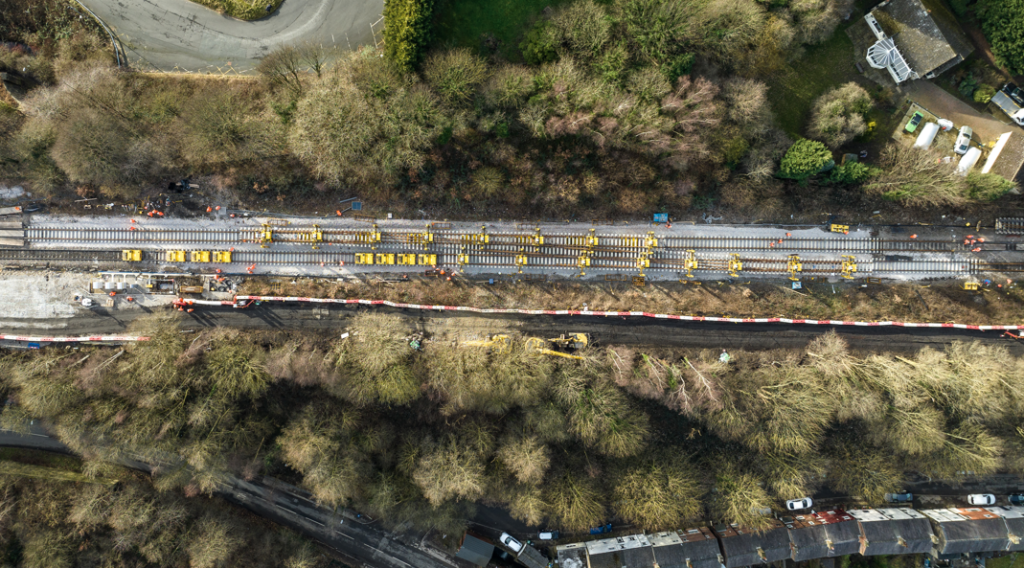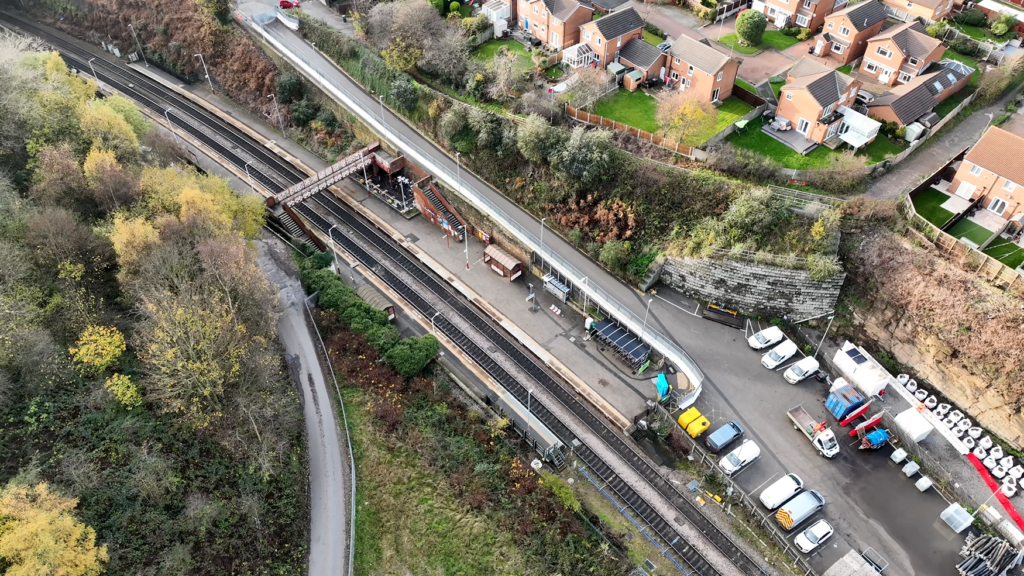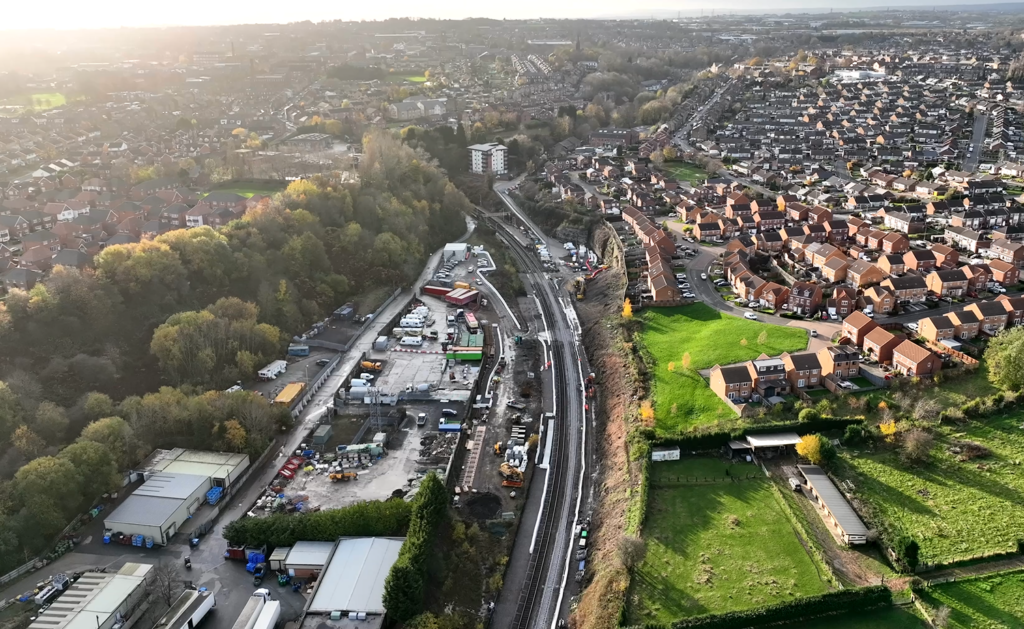Rail Engineer last reported on the Transpennine Route Upgrade (TRU) in Issue 192 (Sept/Oct 2021). The article, Major step forward – Transpennine Upgrade, covered the early works to upgrade the whole 70-mile route between Manchester and York, via Huddersfield and Leeds. The programme is progressing to plan, and we recently met up with Hannah Lomas, industry programme director TRU and David Lawrance technical director and chief engineer TRU, to learn more about the important work to improve train services between Manchester and York.
TRU is a multi-billion-pound, transformative, long-term railway infrastructure programme to improve connectivity for both passenger and freight services, and to support economic growth in the north. The programme also employs a number of innovative engineering techniques to increase efficiency and save costs. Transpennine is a busy, challenging route through built up areas, with difficult access. Very few work sites are on flat land and the geology is interesting as it goes through areas where rock is shallow and follows river valleys up and down the Pennines. The route serves 23 stations, crosses over and under dozens of bridges and viaducts, passes through six miles of tunnels, and over 29 level crossings. It also goes through areas with a history of mining.
Scope
The overall scope of TRU has changed a few times over the years, but the programme outputs are now fixed. The headline route improvements will be full end-to-end electrification of the Manchester to York route with journey times from Manchester to York improved from the current 73-98 minutes to 63-66 minutes, and Manchester to Leeds from the current 49-51 minutes to 41-42 minutes. A 50% reduction in average minutes train delay will also be provided, with a train capability of eight x 24 metre carriages.
The programme improvements will enable more trains to run between Manchester, Leeds, and York, with up to six fast/semi-fast services every hour between Leeds and Manchester and up to two stopping services for local connectivity.
W12 freight gauging clearance will be provided between Manchester Victoria and Thornhill Junction, which will require significant work to Stalybridge tunnel. Known as the W2C project a third track will be provided between Huddersfield and Marsden, primarily for freight trains and to increase capacity on the route ready for the larger Northern Powerhouse Rail (NPR) scheme. NPR will be designed to provide better regular services between Newcastle, Sheffield, Hull, Leeds, Manchester, and Liverpool.
November 2022 saw the first section of electric overhead wires installed on the route, with the wires up between Church Fenton and Colton Junction, where the line from Leeds joins the East Coast Main Line into York. This is one of the busiest stretches of railway in the north, with over 100 trains using the line each day.

Stalybridge remodelling of the west end of the station has recently been successfully completed and is typical of the many projects and blockades that make up the overall TRU programme. The remodelling built on work delivered in 2012, which increased the number of platforms from three to five to provide train overtaking opportunities. The station approach has now been completely remodelled with over 2km (1.2 miles) of new track, 23 new signals, 13 crossovers upgraded, provision of overhead line equipment foundations, and line speeds across the west junction increased to 50mph for all through routes.
Morley station at the east end of Morley Tunnel is being completely upgraded and moved 75 metres away from the tunnel entrance, to allow line speed improvements, longer trains, and more passengers to use the station. Step-free access throughout the station is being provided via a new footbridge with lifts and an access ramp to the station. Batley signal box is also being abolished with control transferred to the York Rail Operating Centre (ROC), along with the provision of a crossover to facilitate train diversions.
The work is typical of that being provided across all of the TRU stations with ‘Access for All’ bringing passengers a better travel experience through improved, more accessible stations. These include Blue Badge parking spaces with improved car parking layouts, waiting shelters designed to accommodate wheelchairs and double buggies, new seating and new lighting, tactile paving, and braille markings, together with much improved customer information systems.
Project W3 is a very large project within the TRU programme and concerns the section between Huddersfield and Ravensthorpe to increase capacity, as this is where many local and freight trains cross. W3 will double the number of tracks from two to four between Huddersfield and Westtown (Dewsbury), with grade separation at Ravensthorpe, and will deliver improvements to Huddersfield station including an increase from three to four through platforms. The outline design was completed at the end of 2022 and the detailed design and mobilisation of this significant work package is now underway.
A Transport and Works Act Order (TWAO) was granted in the autumn of 2022 to enable W3, as there is some greenfield work for the grade separation and significant work required at the Grade I listed Huddersfield station. The TWAO was the biggest Network Rail had ever promoted, which illustrates the scale of the TRU programme; and the number of objections to the TWA was low which also illustrates the quality of the TWAO submission by the programme team and the support for TRU from the general public. The TWAO was also obtained six months earlier than planned.
Delivery
In terms of delivery of the TRU programme, to the west of Leeds the TRU West Alliance is a partnership of Network Rail, Amey, Bam Nuttall, Siemens, and Arup. There is another alliance, TRU East, which is upgrading the route between Leeds and York, consisting of Network Rail, J. Murphy & Sons, VolkerRail, Siemens, and Systra. Jacobs is looking at the overall system integration and there is major focus on a system approach to the programme. Some very experienced rail engineers are helping the TRU programme with the lessons learned from other rail infrastructure projects such as Crossrail.
TRU is made up of many projects which are at various stages of delivery maturity. For example E1 – Church Fenton to York, W1 – Manchester to Stalybridge, and W2A – Stalybridge are in their construction stage. E234 – Leeds to Church Fenton, W2B – Stalybridge to Marsden, W3 – Huddersfield to Ravensthorpe, W4 – Ravensthorpe to Leeds, and ETCS signalling are in the design/mobilisation stage.
TRU has been asked to develop three multi-tracking projects and additional digital signalling, which both formed part of the original NPR design (pre-IRP). These options are being developed and need to go through a validation process to ensure they deliver the agreed benefits for passengers and to support the wider TRU programme ambition to run 15 more freight trains each day.
The programme is carrying out significant resilience works to the diversionary routes – Calder Valley, Castleford, and Healey Mills. This will ensure when the core route is closed for delivery, up to three trains per hour can be diverted and passengers can be kept on trains. These works are progressive but will largely be complete by end of 2023 and are known as key output stage one.
This improved capacity and reliability of the diversionary routes will also provide longer term legacy benefits to passengers. Key output stage two will see electric trains start to operate from Manchester to Stalybridge, with greener and more reliable trains for passengers by the middle of the decade.


Innovation
As well as learning from the mistakes of past railway projects and programmes, TRU is also looking to use the latest innovative and creative technologies and solutions. For example, the programme is using a comprehensive programme-linked construction model to time link machine movements and potential clashes, crane positions, demarcation of work areas, temporary works, exclusion zones, equipment positioning, and traffic management.
A collaboration hub known as the Control Room has been created. This comprises a six-screen digital collaboration hub and an immersive ‘BIM Cave’ with a 4D model, which brings the construction data to life within a shared digital environment. This allows the client, planners, site managers and engineers to track real-time project performance, and allows them to compare the plan against what is being delivered in real time. Teams collaborate physically or remotely with progress streamed live. The system has already received a number of industry awards for construction innovation.
The programme is also looking to create a digital twin at the completion of the work to ensure all the digital information created is not wasted and is available to manage the assets through their whole life. Contact has been made to learn from similar projects in Belgium and Australia, and to understand how they have delivered their systems.
Mining hazard remediation is another area that TRU is looking at which may benefit the whole rail industry. The UK has a wide range of hazards caused by the mining methods and technology available at the time of the work. The legacy of this activity is numerous caverns, voids, broken ground, tunnels, and shafts near or under railways. Underground workings, particularly where shallow, may collapse and cause surface settlement. W3 in particular goes through a legacy mining area.
Historically, the traditional mitigation has involved ground consolidation, with grout injected under pressure to fill the voids and to replace or maintain the support lost by mining excavation. This can be very expensive and take years to implement. TRU is therefore applying explicit risk estimation, which is a probabilistic method of determining how much effort and cost should be invested in safety measures to mitigate the safety risk. The key is to determine and apply appropriate safety measures and not to be too risk adverse. It’s likely that the approach taken by TRU may be incorporated into national standards for mining risk near railways.
A lot of effort has also gone into delivering electrification more efficiently with the use of Voltage-Controlled Clearances (VCC). Railway electrification delivery and costs have been greatly affected by the challenges in providing sufficient electrical clearances between the contact line system and nearby structures. This can, and has on other schemes, lead to major and expensive civil engineering works to provide safe clearances. VCC uses surge arresters to control the magnitude of the voltage between contact line and the structure to allow the physical separation distance to be controlled and significantly reduced. This will dramatically reduce the amount of over bridge and tunnels work, and in particular at Summit Tunnel, which has very tight clearances.
High output plant machines for more efficient electrification and track renewals are also being looked into, given the volume of work required for TRU, and is a major efficiency opportunity for the programme.
Social values
Sustainability and social values are another important feature of the programme. There are targets for the locality of workforce, apprentice schemes and initiatives for carbon reduction. TRU has published its sustainable development strategy, which includes creating 4,000 new opportunities and safeguarding jobs during construction, employing 590 apprentices, and over 30,000 placement days to support new entrants joining the industry. The strategy also involves ensuring 60% of the project workforce is employed from within 25 miles of the route and 80% within 40 miles. A minimum of 25% of the project supply chain spend will be with local businesses, within 25 miles of the route, along with 33% of project spend with small to medium sized enterprises, micro businesses, and voluntary sector organisations.

A carbon reduction fund has also been established, which projects can draw on if they have a carbon reduction initiative, which may cost more than a traditional higher carbon solution. A carbon reduction training course has also been put in place and over 100 engineers have so far been trained and ideas are already starting to be created.
The TRU programme is taking place on both the Eastern and North West & Central Regions of Network Rail, which historically had different ways of working, practices, standards, and infrastructure. Is this a problem to the programme we asked? Not at all said Hannah and David.
Consensus specifications have been established for the programme, which will apply to the whole route and with the approval of both regions. This has also given the opportunity to gain the benefit of a wider range of experiences and adopt the best practice from two regions. Each month, a Technical Assurance Group meet with representatives of both regions and TRU to review the key risks and issues to the programme and to achieve a consensus.
TRU is an impressive programme which is providing a greener, more reliable, and faster railway in the north, and which will provide less than an hour journey time from Manchester to Leeds/York, with more trains. It is not just the major cities which will benefit, as many smaller towns will stand to gain from better stations along with faster and more reliable greener trains.
The TRU programme is said by some to be the most expensive least-talked-about project in the county. Maybe that is because it is going so well? Rail Engineer therefore looks forward to further reporting on the programme as the work continues.

